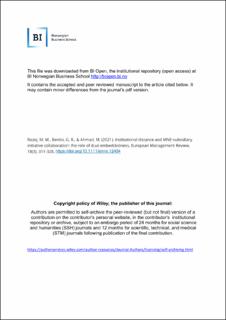| dc.contributor.author | Raziq, Muhammad Mustafa | |
| dc.contributor.author | Benito, Gabriel R G | |
| dc.contributor.author | Ahmad, Mansoor | |
| dc.date.accessioned | 2023-09-23T07:35:19Z | |
| dc.date.available | 2023-09-23T07:35:19Z | |
| dc.date.created | 2021-02-17T12:35:47Z | |
| dc.date.issued | 2021 | |
| dc.identifier.citation | European Management Review. 2021, 18 (3), 311-328. | en_US |
| dc.identifier.issn | 1740-4754 | |
| dc.identifier.uri | https://hdl.handle.net/11250/3091498 | |
| dc.description.abstract | Entrepreneurial initiatives by subsidiaries are greeted as well as contested. We examine the effect of institutional distance between the host country of a subsidiary and the home country of its parent multinational enterprise (MNE) on the resource support a subsidiary receives from the MNE for its entrepreneurial initiatives. Drawing on social exchange theory, and resource dependence theory, we argue that while informal institutional distance inhibits MNE resource support for initiatives, and formal institutional distance further exacerbates the subsidiaries' options, external embeddedness and reverse knowledge transfers may help subsidiaries bypass the negative effects of institutional distance and encourage MNE involvement in subsidiary initiatives. Using survey data from 429 foreign subsidiaries in New Zealand, and secondary data on formal institutional distance from the Worldwide Governance Indicators, the results from structural equation modeling provide support to our hypotheses. This study extends institutional distance, embeddedness, and subsidiary initiative research. Importantly, it contributes by demonstrating how contingencies such as dual embeddedness and (low) formal institutional distance can counterbalance the negative effects of informal institutional distance on subsidiary initiatives and MNE-subsidiary initiative collaboration. | en_US |
| dc.language.iso | eng | en_US |
| dc.publisher | Wiley | en_US |
| dc.subject | Institutional Distance | en_US |
| dc.subject | External Embeddedness | en_US |
| dc.subject | Reverse Knowledge Transfers | en_US |
| dc.subject | Dual Embeddedness | en_US |
| dc.subject | MNE-subsidiary Initiative Collaboration | en_US |
| dc.title | Institutional distance and MNE-subsidiary initiative collaboration: The role of dual embeddedness | en_US |
| dc.type | Peer reviewed | en_US |
| dc.type | Journal article | en_US |
| dc.description.version | acceptedVersion | en_US |
| dc.rights.holder | Wiley | en_US |
| dc.subject.nsi | VDP::Økonomi: 210 | en_US |
| dc.subject.nsi | VDP::Economics: 210 | en_US |
| dc.source.pagenumber | 311-328 | en_US |
| dc.source.volume | 18 | en_US |
| dc.source.journal | European Management Review | en_US |
| dc.source.issue | 3 | en_US |
| dc.identifier.doi | 10.1111/emre.12454 | |
| dc.identifier.cristin | 1890836 | |
| cristin.ispublished | true | |
| cristin.fulltext | postprint | |
| cristin.qualitycode | 1 | |
